Learn how to safely introduce and serve nuts to babies and toddlers to avoid choking risks and offer up a load of nutrition. Win win!
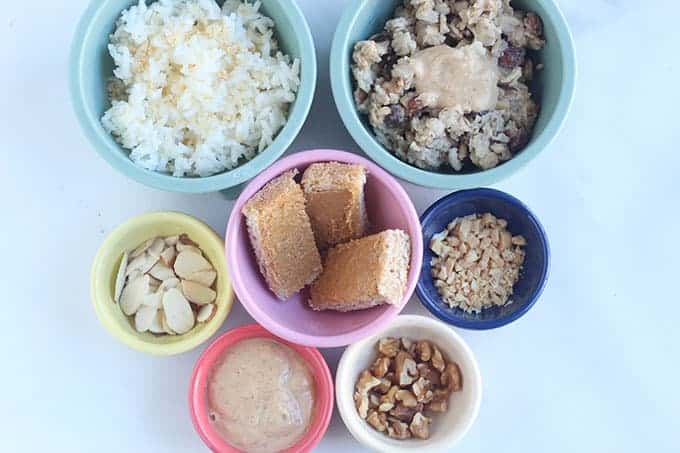
Nuts for Kids
There aren’t many foods that I say NO to for kids, but whole nuts are a choking hazard until at least age 4, which I know is surprising to some. Plus, spoonfuls of nut butters can be way too sticky for little mouths to handle, which can also cause potential trouble.
Here’s the good news though: There are SO many yummy options for how to serve nuts that offer up the healthy fats, protein, and more that are easier for the kids to chew and swallow! Plus, nuts and seeds are a great source of healthy fats, protein, and vitamins and minerals including Vitamin E and iron. So incorporating them into their diets is a great way to add nutrients.
P.S. Guidelines from the American Academy of Pediatrics recommend that we introduce allergens, including peanuts, to babies soon after they start solids UNLESS there is a family history of food allergies or the baby has had or has eczema. Always be in touch with your pediatrician for medical advice and with any concerns about introducing potential food allergens.
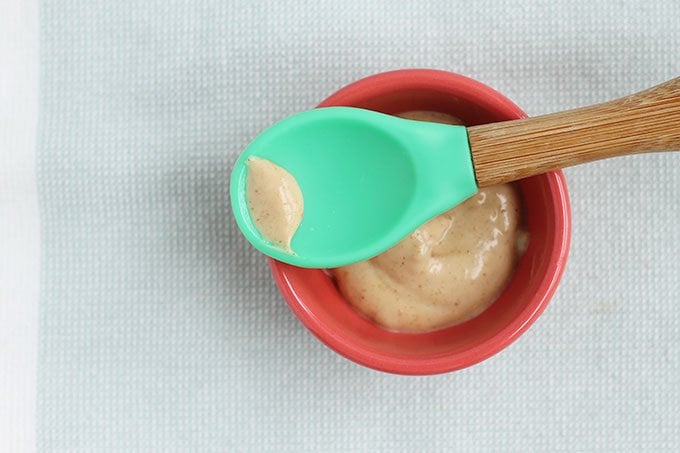
Peanut Butter Puree
This is my go-to way to serve peanut butter to babies and it’s such a flavorful and nutrient-rich food for littles. All you need is unsweetened peanut butter and warm water to mix up a fluffy puree! (It has the consistency of yogurt!) You can serve this on a spoon like any other puree or add to oatmeal or yogurt.
TIP: Find the full info on how to Introduce Peanuts to Babies here.
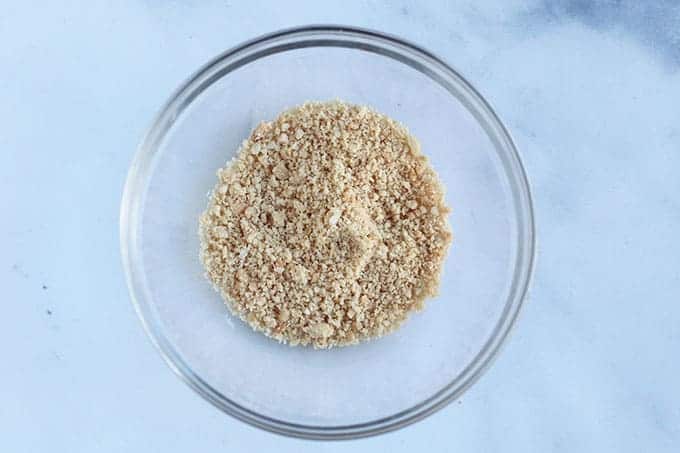
Nut Powder
Grinding up a homemade nut powder by blending up whole nuts into a fine dust-like powder. This adds texture and nutrients! You can sprinkle on grains, meat, veggies…anything you like! Scroll down to the bottom of this post for the specifics on how to do this.
TIP: Using this sort of a nut powder can help toddlers with texture aversions too.
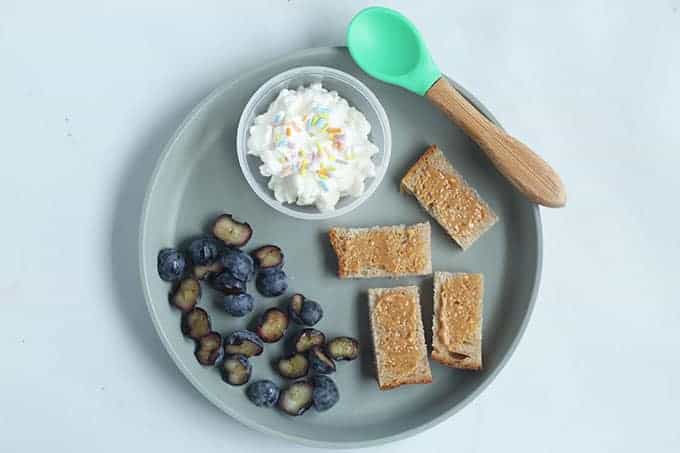
Peanut Butter Toast
Try a thin smear on toast, pancakes or waffles. The key here is thin, not globs, to ensure that this is easy to chew. This also works as a baby led weaning food for younger babies to gnaw on on a finger-size piece of lightly toasted bread.
TIP: I toast bread lightly for younger toddlers, verses untoasted bread, simply because the texture difference makes it a little easier to chew—and a little less likely to get stuck on the roof of their mouths.
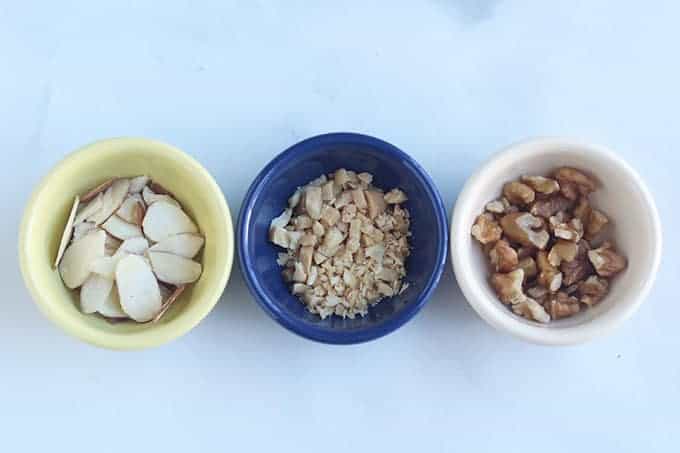
Chopped Nuts and Seeds for Kids
For kids over about 20-22 months, try finely chopped or finely sliced nuts as an option. Sit with them and give a very small amount to make sure they do okay as it take some practice to learn the new texture.
You can also soak cashews and chop them for an even softer option.
Roasted sunflower seeds are a good option from about 2.5/3 years and up. I’d do pumpkin seeds a little later than that since they can be hard to chew.
Halved cashews, walnuts, or peanuts are a good option for kids about 3 + years. (I am being conservative here just to err on the safe side of things.)
Best Tips for Success
- Avoid whole nuts until age 4.
- For babies, start with Peanut Puree or a thin amount of nut or seed butter on lightly toasted bread BLW style.
- You can also add any nut or seed butter to smoothies, yogurt, or oatmeal.
- Try Easy Peanut Sauce, Strawberry Smoothie, Apple Raisin Oatmeal, or Peanut Butter Chocolate Muffins.
- Try Bamba puffs, Puff Works Baby or Mission Mighty Me puffs as other safe snacking options.
I’d love to hear your feedback on this post, or any questions you may have, so please comment below!
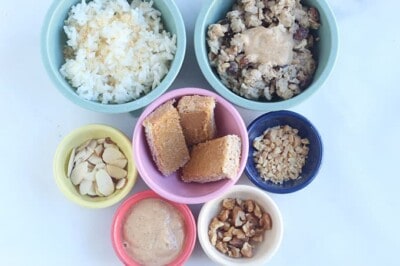
How to Serve Nuts to Babies and Toddlers
Ingredients
- 1 cup roasted unsalted peanuts, almonds, or walnuts
Instructions
- Add the nuts to a blender. Secure on the lid and grind, starting on low and working up to high. Grind to form a powder (the time it take will vary on the nut and its firmness), but before it turns into nut butter. You will be able to visually tell when it's a powder.
- Store in an airtight container in a cool dry place or in the fridge for up to 3 months. You can also freeze for up to 6 months.
- Sprinkle over veggies, grains, meat, oatmeal, banana slices, or any other food that sounds good to you!
Notes
- You can serve the nut powder from about ⅞ months and up.
- Roasted cashews may also work.
- Peanut Puree (either on a spoon or stirred into oatmeal)
- Peanut Butter Toast: Lightly toast bread and add a thin layer of nut or seed butter.
- Peanut Butter Oatmeal Energy Balls(dice up for kids under about 18 months)
- Easy Peanut Sauce
- Add to a Strawberry Smoothie
- Finely chopped peanuts, walnuts, or cashews for kids 20/22+ months.
- Halved cashews, walnuts, or peanuts for kids about 3 + years.



















My two and a half year old loves eating nuts and raisins out of my tail mix. Most of the nuts are halved and he’s never had a problem crunching or chewing them. Should I have any reservations about letting him eat these nuts and dried fruits whole?
Personally I would be fine with the dried fruit but I’d stick with the halved nuts since whole nuts are generally considered to be a higher risk for choking until age 4. If he’s doing well with the nuts as they are, I’d stick with it!
What about shelled pumpkin seeds? What age would these be safe to give?
probably closer to 4 since they are fairly hard to chew.
What are your thoughts on giving a 2yr old nuts that have been baked like whole walnuts in banana bread or halved peanuts in a granola bar?
Typically walnuts in baked goods are soft and easier to chew. With the granola bar, it may depend on how chewy or crunchy the rest of the bar is. That would impact how hard the whole thing would be to chew. Usually halved or broken peanuts are okay, but I’d chew that bar yourself and make sure it’s easy to chew.
It’s a Southern thing, but boiled peanuts would be great! They’re super soft and easy to chew. They mash really easily. The only thing is they’re usually prettt salty. But you can make your own easily at home with a crockpot.
That’s a great idea, thank you for sharing that!